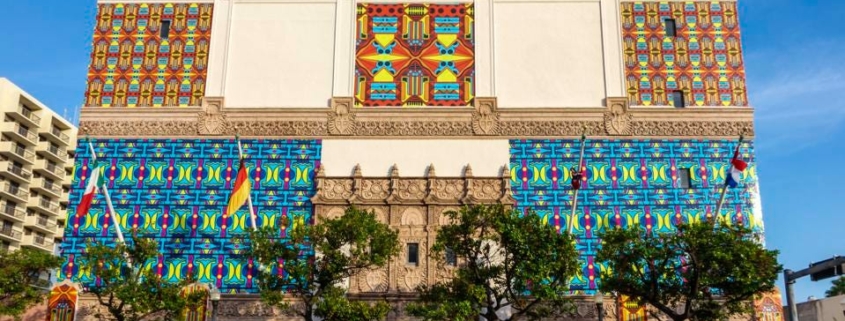Wolfsonian-FIU, Museum Of Graffiti, Prove Bigger Isn’t Better In Miami’s Dynamic Arts Scene
Miami’s vibrant arts scene goes big.
Big museums like the Rubell and Perez. Big fairs–the biggest–Art Basel Miami Beach. Big murals at Wynwood Walls.
Two of the city’s smaller institutions, however, currently prove that scale alone does not equate to quality. As the COVID-19 pandemic continues eliminating big exhibits, big loans and big crowds across the public art sector, the Wolfsonian-FIU and Museum of Graffiti prove big experiences can still be found in small spaces with near-private attendance.
Three of the most powerful exhibitions anywhere in South Florida can be seen now at the Wolfsonian-FIU, Florida International University’s modern art museum located in the heart of Miami’s Art Deco district. highlights the trio.
The case of the “Scottsboro boys”—nine Black youths falsely accused of rape in Alabama in 1931—ignited an international campaign to save them from the electric chair. The Communist Party U.S.A. took up their legal defense, organized mass demonstrations and published pamphlets and magazines exposing the brutality of white supremacy. “Art for Justice” features an original manuscript of linoleum-cut prints illustrating the Scottsboro Boys’ story within the longer arc of racial injustice and resistance in the U.S.
The presentation proves as chilling and resonant now as when the images were created 90 years ago. Themes picked up in the artwork starkly deal with mass incarceration, inequities in education and job prospects between Blacks and whites, and the .
In a gallery no larger than Miami nightclub bathroom, the nation’s 400-year history of brutalizing Black people is concentrated through the lens of a near-tragedy almost entirely lost to America’s whitewashing of its racist history.
How many similar incidents ended not with pardons and exoneration, but the hangman’s noose? What of this tragedy being avoided only through the determined advocacy of the Communist Party U.S.A.? How much progress toward racial equality has the country made? When will these themes read as antiquated and not a part of America’s contemporary condition?
“Art for Justice” demands visitors think deeply, feel deeply, look closely.
(For those who find this subject matter appealing, similar themes adapted for a global scale are now on view at during its current exhibition, )
The Wolf also currently displays a tidy selection of its enormous permanent collection of HIV/AIDS posters, numbering over 2,000, donated by Henry S. Hacker.
Prior to COVID-19, but just like the current pandemic, HIV/AIDS for 35 years spurred empathy and compassion along with hostility and ignorance. They were co-opted as a pillar in the culture wars. Politicians fought over causes and funding while people suffered. and offer education through public artwork as many of those occupying the highest offices of power in the nation ignored the catastrophe.
These posters serve as remarkable documentation of the era and examples of visual communication seeking empathy and community in the face of a global health crisis.
Lastly, The Wolf presents “The New Deal: Art Relief” a similarly prescient example from the nation’s past reflecting upon how federal funding for the arts can sustain not only artists, but the nation, through economic collapse.
100,000-square-feet of exhibition space and a $10 million budget couldn’t eclipse for timeliness and impact what the Wolfsonian-FIU shares presently. Museum directors from across the nation should study it as an example of how thoughtful acquisitions over time and responsive curation to current events can combine to serve their communities.
Without a sprawling collection spilling over into multiple wings, a visit to The Wolf still allows plenty of time to explore other aspects of this famed section of Miami Beach.
.
Enjoy a on peachy Española Way, a destination in its own right. The first commercial development on Miami Beach in the early 1920s, Española Way was built to serve as an artists’ colony with a creative atmosphere that mirrored Greenwich Village in New York and the artists’ quarter in Paris. Having undergone a multi-million dollar renovation in 2017, the festive street is now off-limits to vehicles and the perfect Instagram backdrop.
For a completely divergent and digital art experience, bathe in the immersive lights and sounds at .
All of this is can be found within a few blocks of each other eliminating the need for a car and allowing visitors to soak up the colorful sights and sounds of the neighborhood.
Across MacArthur Causeway in Wynwood, best know for the world’s greatest concentration of graffiti, street art and murals, traces the fascinating origins of everything to be seen on the walls outside.
Filling a footprint not as large as two subway cars side-by-side, the museum charts the unlikely rise of street art from its inception as the hobby of New York youths with nothing better to do during the city’s bottoming-out in the 1970s, to become the most popular art form in the world today. Original artwork and an extraordinary collection of rare ephemera are placed into tight storytelling by Alan Ket.
Ket is a graffiti artist, art historian, collector, author of numerous books on the subject and . He’s as knowledgeable as anyone in the country on the graffiti movement. Visitors would be well-advised to ask for him upon arrival to see if he has a few minutes to share his enthusiasm.
While there, be sure to use the bathroom. You’ll understand why when you–“go.”
Opened in fall of 2019, the pocket-sized museum already feels like an indispensable feature of Miami’s dynamic arts community.
For the best of everything Miami Beach has to offer–local artwork, exceptional dining, access to nightlife, a fabulous pool oasis right on the beach –accommodations at serve as the perfect headquarters for any trip to the area.
Source: Forbes – Wolfsonian-FIU, Museum Of Graffiti, Prove Bigger Isn’t Better In Miami’s Dynamic Arts Scene




